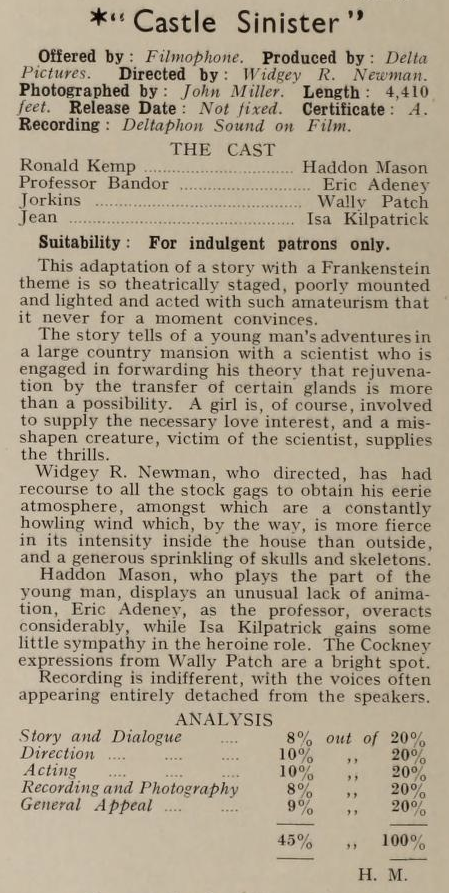‘Castle Sinister’: The Terrible 1932 British Horror Film Lost in Time

Castle Sinister, released in 1932, was a 50 minute (4410 foot long) black and white British horror film produced by Delta Pictures that’s now classified as ‘lost media’. The film is so obscure that there is no remaining footage, stills, teasers, or posters and most of the actors don’t have any photos available online. It’s unfortunately common for early films to vanish, especially those made in the silent film era before 1929 and early talking pictures from the 1930s.
The year 1932 saw the release of over 100 films with the majority falling in the genres of comedy and thriller while Castle Sinister stood practically alone in the horror genre. It’s possible it was made for an audience that wasn’t really there. Despite it’s mediocre reputation (which I’ll cover below), there was another reason why Castle Sinister has vanished off the face of the earth.
Castle Sinister was directed by Widgey R Newman who, during his short life, contributed many early B-Films to British cinema. Born in 1900 in Bedford, Newman specialised in a type of film called ‘Quota Quickies’, which were cheap, low-quality, and quickly made films created in response to The Cinematograph Films Act of 1927. Under the act, film distributors and venues were required to use a minimum quota of films classified as ‘British’ (production under a British person or company, shot in a British studio, and at least 75% of the cast being British).
Quota Quickies were filmed in a rush over a few days on a tight budget and were more often than not terrible quality. A quick look at Newman’s filmography shows the staggering number of films he was putting out (eleven in 1927 and twenty-nine during the 1930s) before his death in 1944. According to film historians, Quota Quickies would play to mostly empty theatres, often while staff were cleaning. Unfortunately (for those of us that love terrible movies), at least 60% of these Quota Quickies including Castle Sinister are considered lost media.
What was Castle Sinister about?
Unfortunately almost nothing is known about the actual content of the film. Set in a mansion in the Devon countryside, a mad scientist attempts to transplant a girl’s brain into an ‘apeman’s’ head. The scientist hopes to prove his theory of rejuvenation via the transfer of glands. That’s… pretty much it. The film seems to borrow elements of classic Gothic Horror that was starting to pick up traction in the cinema world with Dracula and Frankenstein hitting cinemas a year earlier and the Alfred Hitchcock classic Rebecca in 1940. With a 50 minute runtime I’m sure a lot more happened, but it’s likely we’ll never know.
The Dimly Lit Stars of Castle Sinister

The cast of Castle Sinister is almost as obscure as the film itself. Only five actors are listed and very little is known about the majority of them. However, we do know the name of the characters they played, which gives a little more context to the plot. The cast included:
Haddon Mason (as Ronald Kemp)
Mason was born on 21 February 1898 in London. He is credited in 29 films between 1925 and 1940, including a role in an early version of The Woman in White in 1929. He was married to British actress Maudie Dunham (1897-1982) and died on 29 April 1966 at the age of sixty-seven in London. Despite my best efforts, I can’t find a single photo of him.
Eric Adeney (as Professor Bandor)
Adeney was born on 21 August 1888 in Tunbridge Wells and has only four acting credits to his name including a small role in a version of Hamlet from 1913. He died in Trethevy on 4 November 1953. I was also unable to find any photos of Adeney.
Wally Patch (as Jorkins)
Patch was born on 26 September 1888 and was an actor and comedian who had roles in film, television, and theatre. Patch had a long and busy career appearing in over 210 films during his lifetime and worked until his death in 1970. Unlike Mason and Adeney, it’s much easier to find photos of Patch due to the insane amount of work he’d done. Watch him in action in a clip from an episode of Race Track from 1937.
Ilsa (or Isa?) Kilpatrick (as Jean)
Castle Sinister seems to be the only film Kilpatrick (real name Isabel Christina Moore) ever appeared in. She was born on 24 September 1908 in Durban, South Africa and was married to Willem Johannes Woltman and later to William Kilpatrick. I couldn’t find anything else about her, I assume she was a friend or family member of someone on the production team and stepped in to save costs/fill the ‘female quota’.
Edmund Kennedy (as Father)
Kennedy, the final listed cast member, was born in Derby on 8 April 1873. He has acting credits in only three films including Castle Sinister. He was married to Lillian Mason, who appeared in two films, and died on 28 January 1953 in Brighton.
It’s possible there were other actors in Castle Sinister, but there names are lost along with the film. And based off a review of Castle Sinister, it’s probably for the best.
And the Academy Award for Best Picture goes to….
… not Castle Sinister, don’t worry. This probably isn’t surprising, but Newman’s film was apparently really bad. According to a review published in the British film journal The Bioscope in April 1932, Castle Sinister was “so theatrically staged, poorly mounted and lighted and acted with such amateurism that it never for a moment convinces”. Yikes. He criticised Mason’s “unusual lack of animation”, Adeney’s overreactions, and Kilpatrick’s inability to capture the audience’s sympathy. He did however praise Patch’s performance calling it a “bright spot”, which isn’t surprising considering the comedian’s long acting career. And apparently the sound didn’t sync up with the actor’s mouths and “appear[ed] entirely detached from the speakers”.
The Bioscope reviewer gave the film a score of 45/100 with the lowest scores going to ‘Story and Dialogue’ and ‘Recording and Photography’. For ‘General Appeal’, he gave the film 9/20. The more I read about this movie the more desperate I am to watch it. If Castle Sinister is as camp as I imagine, it has potential to be a cult hit if anyone ever manages to find a copy.
Have you seen Castle Sinister?
If you have, the British Film Institute would like to have a word. Castle Sinister is listed on their 75 Most Wanted Films list and has been designated as “Missing, believed lost”. Despite its quality, Castle Sinister is still an important example of early British B-horror and any physical evidence of it’s existence would certainly be welcomed by film historians. So keep your fingers crossed, maybe one day we’ll be lucky enough to watch a badly-acted-black-and-white-brain-transplant-Frankenstein-ripoff from the golden age of British quota quickies. As someone who loves terrible horror films, I’m ready and waiting.
Sources and Additional Reading
British Film Institute – Most Wanted
British Film Institute – Widget R Newman
Cinema History – What Are Quota Quickies?
IMDB – Castle Sinister (1932)
The Guardian – Fancy a quickie?
